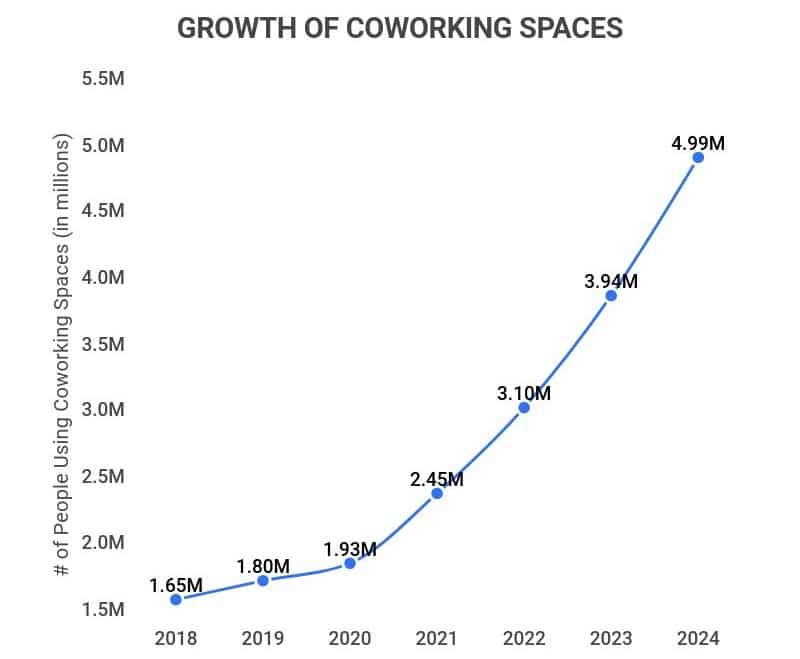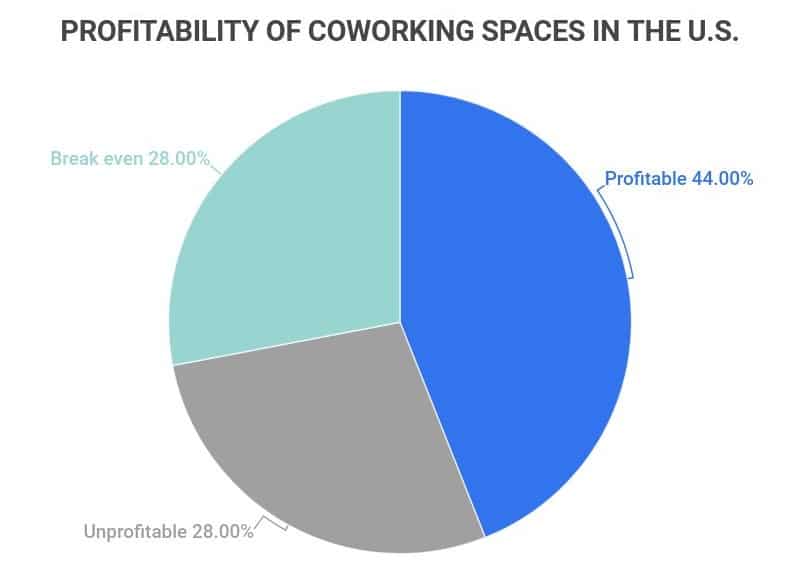Research Summary. Due to improved technology and the effects of the COVID-19 Pandemic, the U.S. has seen an influx in remote workers. While the flexibility of this lifestyle has its definite upsides, there are also drawbacks to not being in an office.
Luckily, that’s where coworking spaces come into play. These spaces provide a productive space for networking, brainstorming, and other positive forms of communication. Overall, here’s what our research on coworking discovered:
-
There are more than 6,200 coworking spaces in the U.S. as of 2022
-
There are approximately 933,000 people in the U.S. who use coworking spaces.
-
In North America, the average size of a coworking space is about 9,799 square feet, with an average of about 100.14 people using that space. That works out to just under 100 square feet per person.
-
The U.S. only had about 4,000 coworking spaces available in 2017, meaning the number of coworking spaces has grown by roughly 55% in 5 years.
-
In 2020, the average monthly hot desk price in North America was $243.
For further analysis, we broke down the data in the following ways:
Trends | Demographics | Reasons for Coworking Space Membership | Benefits | Company

General Coworking Statistics
-
There are approximately 19,400 coworking spaces available in the world, and over 6,200 of those are in the U.S. as of 2022.
-
In 2020, approximately 1.933 million people across the globe used coworking spaces, and about 865,000 of those people live and work in the U.S.
-
The average coworking space around the globe is 7,308 square feet. The average U.S. space is 9,799 square feet.
-
The U.S. has 18.3% of the world’s coworking spaces.
-
The average coworking space in the U.S. fits 105 people. Globally, the average capacity is 83 people.
-
Asia has the highest average capacity with 114 people per coworking space, and South America has the lowest at 54 people.
-
3.4% of the U.S. population was working remotely before the COVID-19 pandemic began in March 2020.

Coworking Statistics Over Time
-
There were only 14 coworking spaces in the U.S. in 2007, and in 2017, there were over 4,000.
-
It’s predicted that there will be over 6,200 coworking spaces in the U.S. by 2022.
-
In 2015, there were about 331,000 people using coworking spaces in the U.S. This number grew to approximately 993,000 in 2021.
-
The number of people working in coworking spaces in the U.S. is projected to hit over one million in 2022.

Coworking Statistics by Demographics
-
The average age of coworking space members around the world is 36 years old.
This doesn’t mean that the majority of members are in their thirties, though. Both younger and older age groups are making up more and more coworking space memberships.
Different age groups of coworking members tend to work in different professions as well. The older members are usually consultants of some kind (which makes sense since they’re the ones with the most expertise in their fields), and younger members are usually in PR, marketing, or design.
-
Women made up over 50% of coworking space members globally for the first time in 2019.
However, if you were to walk into a coworking space, you would likely still see more men than women because men tend to use these spaces more often than women do.
As a result, when they were surveyed, coworking space members and owners said that they estimated women make up only 40% of the membership.
-
In the U.S., almost 90% of coworking members identify as “white or Caucasian.”
This statistic is based on survey data, so if a survey taker declined to answer or selected “other,” they weren’t considered in this calculation. Still, this is a clear majority.
The 5% of members who identified as “Asian” is proportionate to their representation in the rest of the U.S. population.
Those who identified as “Hispanic or Latino” or “Black or African American” made up a percentage much smaller than how they’re represented in the rest of the U.S.’s population, making them greatly underrepresented in coworking spaces as a whole. (This is not always true for individual coworking spaces.)
-
20% of coworking space members work in IT.
This is the largest sector of the professional fields represented by coworking space members, followed by PR and marketing, consulting, and design.
The field of consulting is broad, as this can apply to experts in nearly any field, so if you were to talk to coworking members who fall into this category, you’d find that they work in a variety of industries.
-
42% of coworking space members around the world are freelancers.
The rest are employees of companies. These companies could either be small startups or established corporations.
In large cities around the world and especially in North America, more and more companies are renting out flexible workspaces for their remote employees to work. In Europe and in smaller towns around the world, freelancers make up the majority of coworking space members.
-
80% of coworking space members worldwide have a college degree.
This number has shrunk over the years and is made up mostly of younger workers.
-
After the U.S., India has the greatest share of the world’s coworking spaces.
While the U.S. has almost 20% of the coworking spaces on the planet, India makes up about 10%.
Top 10 Countries With the Greatest Share of the World’s Coworking Spaces (2020)
| Country | Number Of Spaces | World Share |
|---|---|---|
| United States | 3,762 | 18.30% |
| India | 2,197 | 10.69% |
| United Kingdom | 1,044 | 5.08% |
| Spain | 939 | 4.57% |
| Germany | 791 | 3.85% |
| Canada | 617 | 3.00% |
| Australia | 590 | 2.87% |
| Mexico | 508 | 2.47% |
| Japan | 411 | 2.00% |
| Brazil | 393 | 1.91% |
Coworking Statistics by Top Worker Reasons
-
“An enjoyable work atmosphere” is a selling point for 70% of coworking spaces in the U.S., according to a 2019 survey.
Work atmosphere as a selling point for a coworking space is at least somewhat unique to the U.S., as 70% of the country’s coworking spaces that reported this as a selling point is at or above the global average.
Here are some additional selling points for U.S. coworking spaces:
-
“Well-situated location”
-
“Attractive design and fit-out”
-
“Thriving community”
-
“Good service”
-
“Low prices”
-
“Many events”
-
“Free parking”
-
“Multi-location access”
-
“Internet speed”
-
“Wellness emphasis.”
-
-
In 2019, the top sentiments about coworking spaces in the U.S. were:
-
“Being a member of my coworking space makes me feel good.”
-
“I can trust people in my coworking space.”
-
“Members of my coworking community care for each other.”
-
“This coworking community can influence other communities.”
-
-
Between February 2020 and May 2020 (before and after COVID-19 pandemic lockdowns), coworking spaces found an increase in requests for private offices, long-term contracts, and high desk capacities.
This is because companies were shifting the majority of their workforces to remote work, and more people wanted private spaces where they could work away from home while still maintaining social distancing standards.
If the trajectory continues this way, coworking spaces may start to look more like office buildings than they were originally designed to, but employees will still be able to get out of their living rooms and bedrooms so as for them to be around other professionals and entrepreneurs.
Coworking Statistics by Benefits
-
69% of office workers say they are more productive when they can work in a variety of settings during the workday.
Coworking spaces allow remote workers to get a change of scenery by giving them a place to go outside of their homes and by providing a variety of settings for them to work.
-
Globally, 47% of remote workers say that isolation and loneliness are some of the biggest challenges of working remotely.
While almost 80% of those surveyed say they’d recommend remote work to a friend or family member, showing that they generally find it a pleasant experience, remote workers recognize that being around people would make their jobs even better.
Of the participants in this study, 32% worked in a coworking space, and 71% of those coworking space members said they planned to return once the COVID-19 lockdown ended. Of those who had started working remotely for the first time during the lockdown, 55% said they were considering joining a coworking space as well.
Joining a coworking space is a good way to be around people, as 79% say that it has expanded their social networks.
-
83% of coworking space members said that they’re less lonely after joining a coworking space.
Not only do they get to be in the presence of other professionals in a coworking space, but they also get to interact with them as they do their work. 80% of those surveyed said that they look to their coworking comrades for assistance or guidance, and 64% said that they get additional freelance work or projects from the connections they make there.
This ability to have human connection makes a big impact on workers’ overall levels of happiness as well, as 89% reported that they are happier since joining a coworking space.
-
69% of coworking space members said they had learned new skills in a coworking space.
Not only do coworking spaces provide opportunities for human relationships to form, but they also provide opportunities for professionals to learn and grow.
Many coworking spaces offer events, classes, and workshops designed to help their members to develop professionally, just like a company would do for its full-time employees.
A large number of coworking space members take advantage of these opportunities, as 67% of members surveyed said they attend those events at least occasionally.
-
In 2015, researchers discovered that coworking space members score an average of six out of seven on a scale that measures how employees are thriving.
This is a whole point higher than employees who work in more traditional office settings score on average.
The study concluded that there are several likely factors influencing this, such as feeling that their work has more meaning, having more control over what they do and when, and choosing to be a part of a community instead of having to just put up with officemates.
Even those whose jobs aren’t necessarily fulfilling often find that just being able to choose to be a part of an organization that aims to provide a positive and productive atmosphere makes them feel like they’re working toward something meaningful.
Coworking Statistics by Company
-
The top three companies in the U.S. coworking space industry are WeWork, Impact Hub, and Spaces.
WeWork boasts 800 locations around the world and in 2018 became the largest private office tenant in Manhattan, New York City. The company has over 600,000 members and provides hot desks, dedicated desks, or private offices.
Impact Hub has over 100 locations across 50 countries and is still growing. It has over 16,000 members, and it focuses on bringing together entrepreneurs to build community and create sustainable development.
Spaces run over 400 locations around the globe. It began in Amsterdam, Netherlands, but it now has offices on five continents, including North America. This company is unique because it creates a customized contract with each of its members to ensure their needs are met.
Other major players in this industry include:
-
Your Alley
-
Knotel
-
District Cowork
-
Make Office
-
Industrious Office
-
Techspace
-
Venture X
-
Serendipity Labs
-
Green desk
-
SomeCentral.
-
-
Due to the COVID-19 pandemic, the global coworking space market is predicted to decline at a compound annual growth rate of -12.9% in the next few years before it recovers in 2023.
The global coworking space market was valued at $9.27 billion in 2019 and $8.24 billion in 2020.
Economists predict that it will reach $11.52 billion in 2023, though. This recovery is based on the fact that over the last five years, the number of remote workers has grown by 44%.
The only reason why the coworking space market slipped was because of the COVID-19 pandemic precautions, which reduced the number of people using coworking spaces by 50% in March of 2020.
-
44% of coworking spaces in the U.S. were profitable in 2019.
28% had zero profit and zero loss, while another 28% were unprofitable.
The best place to own a coworking space is in a large city, as 60% of these companies are in cities of over one million inhabitants, 39% were in smaller cities of between 100,000 and one million residents, and another 30% were in small towns of less than 100,000 inhabitants.

Coworking Definitions
-
Hot Desk: A desk in a coworking space that isn’t assigned to any one particular person. Often remote workers can pay an hourly, daily, or annual fee that allows them to use one of these desks but doesn’t guarantee that there will always be one available.
-
Dedicated Desk: A desk in a coworking space that is permanently reserved for an individual or organization’s sole use.
-
Flexible Workspace: A flexible workspace is a broad term that refers to any workspace that doesn’t have a defined tenant or purpose. So, a coworking space is technically a type of flexible workspace. Typically, though, the term is used to refer to spaces that companies provide for their remote full-time employees to use for meetings or to have an office to work in.
Coworking Statistics FAQ
-
How many people use coworking spaces?
Nearly 2 million people use coworking spaces globally, with almost half of them being located in the U.S. More specifically, approximately 1.933 million people use coworking spaces across the world, with about 865,000 workers in the U.S. using them in 2020. That number has increased steadily over the past few years, and is expected to see a major rise as the pandemic’s severity wanes and the world has more full-time remote workers than ever before.
In fact, forecasts predict that by the end of 2022, nearly 1.1 million Americans will use coworking, a 27% jump in just two years.
-
How profitable are coworking spaces?
Just under half of all coworking spaces are profitable. 44% of working spaces in America are profitable, while 28% break even and another 28% lose money, as of 2019. However, a big reason why fewer than half of coworking spaces are profitable is because of the relative newness of coworking spaces altogether. A global survey found that 72% of coworking spaces become profitable after operating for two years.
As for how profitable coworking spaces are, a 2016 survey on the U.S. found that the average annual revenue of a coworking building is $505,200. Most coworking spaces earn the lion’s share of their profits on (you guessed it) desk rentals.
-
Is coworking really the future?
Yes, coworking really seems to be “the future,” or at least one part of the future of work. Current remote work statistics estimate that about one-quarter of Americans already work remotely at least some of the workweek, and projections estimate that over 36 million Americans will be working remotely by 2025.
While many remote workers enjoy a work-from-home lifestyle, others find it lonely, boring, or just plain unproductive. As the number of full-time remote workers goes up, there will undoubtedly be a greater number of people who choose to get their jobs done in coworking spaces.
-
Who uses coworking spaces the most?
Freelancers and workers in the IT industry use coworking spaces the most. 42% of coworking space members are freelancers and 20% work in IT. The average age of a coworking space member is 36, 80% of coworking space members have a college degree, and 90% of American coworking space members are white or Caucasian.
-
How many members does the average coworking space have?
The average coworking space has approximently 190 members. That means there are several people to communicate with on the average coworking space, and outlines how much coworking can improve networking. Additionally, this relatively large number of members also explains why coworking spaces might contain various smaller subgroups within them, in order to facilitate more productive chats and meetings.
Conclusion
While each coworking space is different, they all offer a place to focus on work and meet with like-minded people. You can generally set up shop for a day or two each week, work full-time, conduct meetings for your startup, or even reserve spaces for your remote employees to be able to work there when they want.
Coworking has grown rapidly over the past 15 years, and it looks like it’s here to stay. By providing the ever-increasing remote workforce with a place to connect with other professionals, access resources like they’d have in an office setting, and simply step away from their kitchen tables, they’ve created a new normal for the working world.
While the U.S. is a major player in this industry, it’s becoming a global phenomenon as well, making it even easier for remote workers to truly “work from wherever.”
References
-
www.coworkingresources.org. “Global Coworking Growth Study 2020.” Accessed on June 30, 2021.
-
www.statstia.com. “Number of People Working in Coworking Spaces in U.S. 2015-2022.” Accessed on June 30, 2021.
-
www.allwork.space. “Number of Coworking Spaces Worldwide To Double Within the Next 4 Years.” Accessed on June 30, 2021.
-
www.businesswire.com. “Impact of COVID-19 on the Global Coworking Spaces Market, 2020-2030 – ResearchAndMarkets.com” Accessed on June 30, 2021.
-
www.statista.com. “Number of Coworking Spaces in the U.S. from 2007 to 2022.” Accessed on June 30, 2021.
-
www.mordorintelligence.com. “Coworking Spaces in North America – Growth, Trends, COVID-19 Impact, and Forecasts (2021-2026).” Accessed on June 30, 2021.
-
www.deskmag.com. “Coworking Space Members: It’s a girl!” Accessed on June 30, 2021.
-
www.slideshare.net. “2019 USA Coworking Statistics: Selected Results of the 2019 Global Coworking Survey.” Accessed on June 30, 2021.
-
www.yourhana.com. “The Benefits of Coworking Spaces.” Accessed on June 30, 2021.
-
www.coworkinginsights.com. “2020 Future of Work Report: What the Future Holds for Coworking Remote Work.” Accessed June 30, 2021.
-
www.smallbizlabs.com. “Coworking Spaces are Human Spaces.” Accessed on June 30, 2021.
-
www.hbr.org. “Why People Thrive in Coworking Spaces.” Accessed on June 30, 2021.
-
www.coworkingresources.org. “Largest Coworking Companies in the U.S.: 2021.” Accessed on June 30, 2021.





